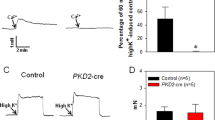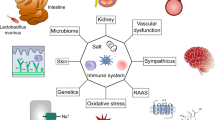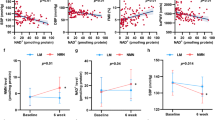Abstract
Enhanced transient receptor potential canonical subtype 3 (TRPC3) expression and TRPC3-mediated calcium influx in monocytes from hypertensive rats and patients are associated with increased blood pressure. Daily salt intake is closely related to hypertension, but the relationship between TRPC3 expression and salt intake has not yet been evaluated in hypertensive patients. Using reverse transcription-polymerase chain reaction, we studied the expression of TRPC3 and TRPC3-related store-operated calcium entry (SOCE) in peripheral blood mononuclear cells (PBMCs) from hypertensive and normotensive control subjects. Measurement of SOCE was performed using the fluorescent dye Fura-2 AM. Participants were divided into a low-salt group (<9 g) and a high-salt group (≥9 g) based on 24-h urinary sodium excretion. Increased TRPC3 mRNA expression levels and SOCE were observed in THP-1 cells after high-NaCl treatment. However, administration of the TRPC3-specific inhibitor Pyr3 significantly decreased the effect. Furthermore, the TRPC3 mRNA expression levels in PBMCs from high-salt intake patients with essential hypertension were significantly higher than those in low-salt intake patients compared with those in normotensive control subjects. We also observed significantly increased TRPC3-mediated SOCE in PBMCs from hypertensive subjects (but not from normotensive control subjects), with calcium concentration correlating with salt intake. More importantly, TRPC3 mRNA levels showed a significant correlation with salt intake and systolic blood pressure in patients with essential hypertension. This study demonstrated, for the first time, that increased TRPC3 mRNA levels are associated with elevated salt intake and systolic blood pressure in hypertensive patients.
This is a preview of subscription content, access via your institution
Access options
Subscribe to this journal
Receive 12 print issues and online access
$259.00 per year
only $21.58 per issue
Buy this article
- Purchase on Springer Link
- Instant access to full article PDF
Prices may be subject to local taxes which are calculated during checkout




Similar content being viewed by others
References
Wilck N, Balogh A, Marko L, Bartolomaeus H, Muller DN. The role of sodium in modulating immune cell function. Nat Rev Nephrol. 2019;15:546–58.
Marketou ME, Maragkoudakis S, Anastasiou I, Nakou H, Plataki M, Vardas PE, et al. Salt-induced effects on microvascular function: a critical factor in hypertension mediated organ damage. J Clin Hypertens. 2019;21:749–57.
Alonso-Carbajo L, Kecskes M, Jacobs G, Pironet A, Syam N, Talavera K, et al. Muscling in on TRP channels in vascular smooth muscle cells and cardiomyocytes. Cell Calcium. 2017;66:48–61.
Abramowitz J, Birnbaumer L. Physiology and pathophysiology of canonical transient receptor potential channels. FASEB J. 2009;23:297–328.
Wang B, Xiong S, Lin S, Xia W, Li Q, Zhao Z, et al. Enhanced mitochondrial transient receptor potential channel, canonical type 3-mediated calcium handling in the vasculature from hypertensive rats. J Am Heart Assoc. 2017;6:e005812.
Smedlund K, Bah M, Vazquez G. On the role of endothelial TRPC3 channels in endothelial dysfunction and cardiovascular disease. Cardiovasc Hematol Agents Med Chem. 2012;10:265–74.
Liu D, Scholze A, Zhu Z, Krueger K, Thilo F, Burkert A, et al. Transient receptor potential channels in essential hypertension. J Hypertens. 2006;24:1105–14.
Liu DY, Thilo F, Scholze A, Wittstock A, Zhao ZG, Harteneck C, et al. Increased store-operated and 1-oleoyl-2-acetyl-sn-glycerol-induced calcium influx in monocytes is mediated by transient receptor potential canonical channels in human essential hypertension. J Hypertens. 2007;25:799–808.
Zhenyukh O, Civantos E, Ruiz-Ortega M, Sanchez MS, Vazquez C, Peiro C, et al. High concentration of branched-chain amino acids promotes oxidative stress, inflammation and migration of human peripheral blood mononuclear cells via mTORC1 activation. Free Radic Biol Med. 2017;104:165–77.
Harrison DG, Guzik TJ, Lob HE, Madhur MS, Marvar PJ, Thabet SR, et al. Inflammation, immunity, and hypertension. Hypertension. 2011;57:132–40.
Tan M, He FJ, Wang C, MacGregor GA. Twenty-four-hour urinary sodium and potassium excretion in China: a systematic review and meta-analysis. J Am Heart Assoc. 2019;8:e012923.
Thilo F, Scholze A, Liu DY, Zidek W, Tepel M. Association of transient receptor potential canonical type 3 (TRPC3) channel transcripts with proinflammatory cytokines. Arch Biochem Biophys. 2008;471:57–62.
Dixit N, Wu DJ, Belgacem YH, Borodinsky LN, Gershwin ME, Adamopoulos IE. Leukotriene B4 activates intracellular calcium and augments human osteoclastogenesis. Arthritis Res Ther. 2014;16:496.
Herrmann AK, Wullner V, Moos S, Graf J, Chen J, Kieseier B, et al. Dimethyl fumarate alters intracellular Ca(2+) handling in immune cells by redox-mediated pleiotropic effects. Free Radic Biol Med. 2019;141:338–47.
Huang L, Crino M, Wu JH, Woodward M, Barzi F, Land MA, et al. Mean population salt intake estimated from 24-h urine samples and spot urine samples: a systematic review and meta-analysis. Int J Epidemiol. 2016;45:239–50.
Xia W, Li Y, Wang B, Chen J, Wang X, Sun Q, et al. Enhanced store-operated calcium entry in platelets is associated with peripheral artery disease in type 2 diabetes. Cell Physiol Biochem. 2015;37:1945–55.
Sun Q, Wang B, Li Y, Sun F, Li P, Xia W, et al. Taurine supplementation lowers blood pressure and improves vascular function in prehypertension: randomized, double-blind, placebo-controlled study. Hypertension. 2016;67:541–9.
Lang H, Xiang Y, Ai Z, You Z, Jin X, Wan Y, et al. UCP3 ablation exacerbates high-salt induced cardiac hypertrophy and cardiac dysfunction. Cell Physiol Biochem. 2018;46:1683–92.
Hsu CN, Lin YJ, Lu PC, Tain YL. Early Supplementation of d-Cysteine or l-Cysteine prevents hypertension and kidney damage in spontaneously hypertensive rats exposed to high-salt intake. Mol Nutr Food Res. 2018;62. https://doi.org/10.1002/mnfr.201700596.
Cao J, Eshak ES, Liu K, Gero K, Liu Z, Yu C. Age-period-cohort analysis of stroke mortality attributable to high sodium intake in China and Japan. Stroke. 2019;50:1648–54.
Galletti F, Strazzullo P. The blood pressure-salt sensitivity paradigm: pathophysiologically sound yet of no practical value. Nephrol Dial Transpl. 2016;31:1386–91.
Weinberger MH. Salt sensitivity of blood pressure in humans. Hypertension. 1996;27:481–90.
Liu HH, Gao XM, Zhou L, Wu Y, Li Y, Mai JZ, et al. Urinary sodium excretion and risk of cardiovascular disease in the Chinese population: a prospective study. Hypertension Res. 2018;41:849–55.
Kurtz TW, DiCarlo SE, Pravenec M, Morris RC. Changing views on the common physiologic abnormality that mediates salt sensitivity and initiation of salt-induced hypertension: Japanese research underpinning the vasodysfunction theory of salt sensitivity. Hypertension Res. 2019;42:6–18.
Liu D, Yang D, He H, Chen X, Cao T, Feng X, et al. Increased transient receptor potential canonical type 3 channels in vasculature from hypertensive rats. Hypertension. 2009;53:70–76.
Chen X, Yang D, Ma S, He H, Luo Z, Feng X, et al. Increased rhythmicity in hypertensive arterial smooth muscle is linked to transient receptor potential canonical channels. J Cell Mol Med. 2010;14:2483–94.
Li P, Wang B, Sun F, Li Y, Li Q, Lang H, et al. Mitochondrial respiratory dysfunctions of blood mononuclear cells link with cardiac disturbance in patients with early-stage heart failure. Sci Rep. 2015;5:10229.
Thilo F, Loddenkemper C, Berg E, Zidek W, Tepel M. Increased TRPC3 expression in vascular endothelium of patients with malignant hypertension. Mod Pathol. 2009;22:426–30.
Xiong S, Wang B, Lin S, Zhang H, Li Y, Wei X, et al. Activation of transient receptor potential melastatin subtype 8 attenuates cold-induced hypertension through ameliorating vascular mitochondrial dysfunction. J Am Heart Assoc. 2017;6:e005495.
Kitajima N, Numaga-Tomita T, Watanabe M, Kuroda T, Nishimura A, Miyano K, et al. TRPC3 positively regulates reactive oxygen species driving maladaptive cardiac remodeling. Sci Rep. 2016;6:37001.
Shimauchi T, Numaga-Tomita T, Ito T, Nishimura A, Matsukane R, Oda S, et al. TRPC3-Nox2 complex mediates doxorubicin-induced myocardial atrophy. JCI Insight. 2017;2:93358.
Ding Y, Winters A, Ding M, Graham S, Akopova I, Muallem S, et al. Reactive oxygen species-mediated TRPC6 protein activation in vascular myocytes, a mechanism for vasoconstrictor-regulated vascular tone. J Biol Chem. 2011;286:31799–809.
Zhao Z, Ni Y, Chen J, Zhong J, Yu H, Xu X, et al. Increased migration of monocytes in essential hypertension is associated with increased transient receptor potential channel canonical type 3 channels. PLoS ONE. 2012;7:e32628.
Acknowledgements
We thank Lijuan Wang, Peng Gao, Tingbing Cao and Hua Yang for their technical assistance. This study was supported by grants from the National Natural Science Foundation of China (81770416, 81630015, 81721001, 81600331) and National Key R&D Program of China (2018YFA0800601).
Author information
Authors and Affiliations
Corresponding authors
Ethics declarations
Conflict of interest
The authors declare that they have no conflict of interest.
Additional information
Publisher’s note Springer Nature remains neutral with regard to jurisdictional claims in published maps and institutional affiliations.
Supplementary information
Rights and permissions
About this article
Cite this article
Hu, Y., Xia, W., Li, Y. et al. High-salt intake increases TRPC3 expression and enhances TRPC3-mediated calcium influx and systolic blood pressure in hypertensive patients. Hypertens Res 43, 679–687 (2020). https://doi.org/10.1038/s41440-020-0409-1
Received:
Revised:
Accepted:
Published:
Issue Date:
DOI: https://doi.org/10.1038/s41440-020-0409-1
Keywords
This article is cited by
-
Dietary salt intake predicts future development of metabolic syndrome in the general population
Hypertension Research (2023)
-
Salt and Gut Microbiota in Heart Failure
Current Hypertension Reports (2023)
-
Role of store-operated Ca2+ entry in cardiovascular disease
Cell Communication and Signaling (2022)
-
Canonical transient receptor potential channels and their modulators: biology, pharmacology and therapeutic potentials
Archives of Pharmacal Research (2021)
-
Biochemical interaction of salt sensitivity: a key player for the development of essential hypertension
Molecular and Cellular Biochemistry (2021)



